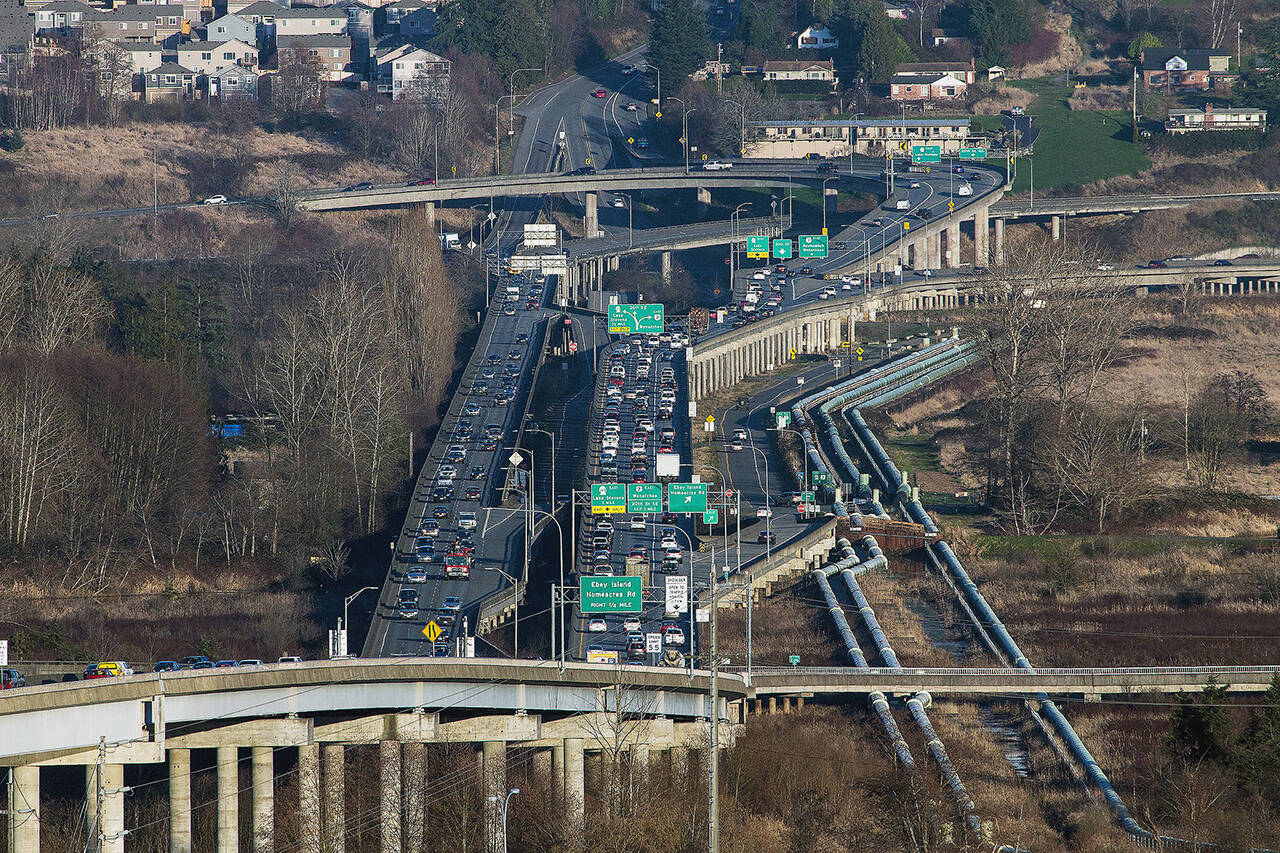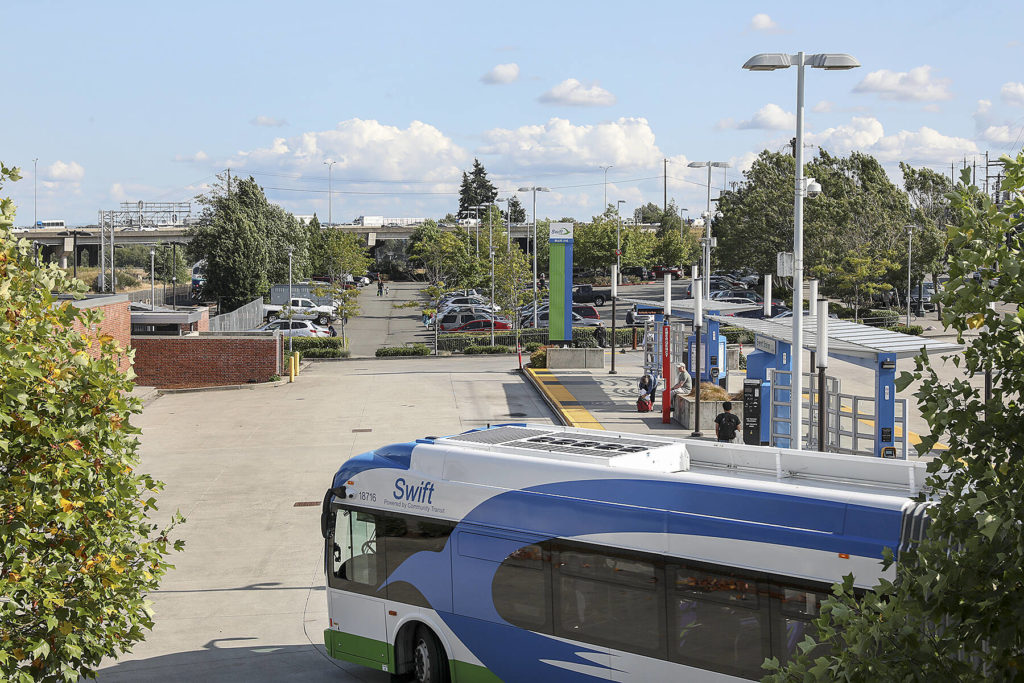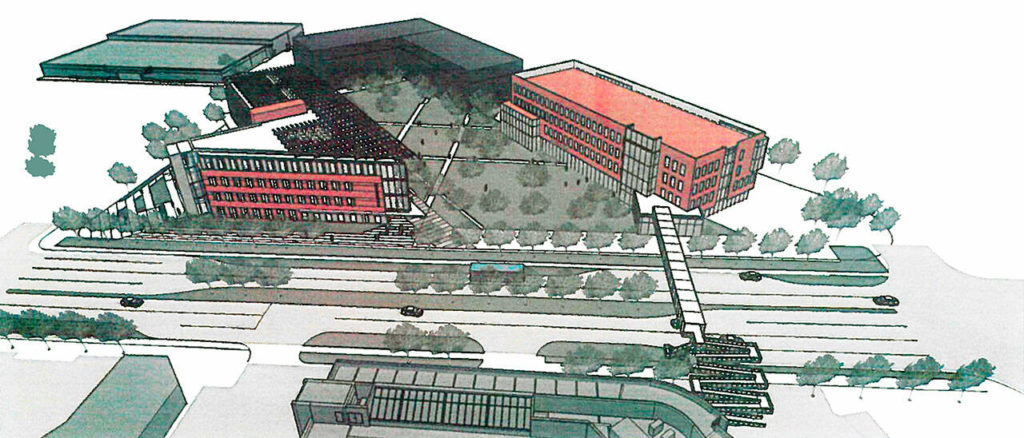OLYMPIA — Culvert replacement, expanded bus service, four electric state ferries and free transit for those 18 and younger.
They’re all part of Democratic state lawmakers’ 16-year, $16.8 billion transportation package unveiled Tuesday.
In Snohomish County, there’s money for highway projects, bus investments, ferry terminal upgrades and path improvements for bikes and pedestrians.
Sen. Marko Liias, D-Everett, said the Move Ahead Washington revenue and spending plan should transform the state’s investments in climate action, as well as move people and freight.
“People move around our state in many ways and this recognizes that,” said Liias, the first-year chair of the Senate Transportation Committee. “We should see less pollution and more people moving through our transportation system more efficiently.”
Liias and Rep. Jake Fey, D-Tacoma, his House counterpart, did the heavy writing of the blueprint. They released details at a news conference surrounded by fellow Democrats from the two chambers.
Democrats didn’t involve Republicans in writing the plan. But it contains elements long pushed by the minority party, such as using general fund dollars for transportation and emphasizing preservation of existing roads, highways and bridges.
“I find that pretty interesting,” said Rep. Carolyn Eslick, R-Sultan, assistant ranking Republican on the House Transportation Committee. “I think the jury is still out on how wonderful it is until we do a deep dive. Our caucus has not had a chance to do that.”
The Senate Transportation Committee will hold a hearing on the plan at 8 a.m. Thursday.
Move Ahead Washington earmarks $3 billion for preservation and maintenance; $3 billion for transit; $2.6 billion for new highway projects; $2.4 billion for fish-barrier removal; $1.2 billion for bike, bus and pedestrian work; and $1.1 billion for state ferries.
To pay for it, Democrats are tapping into several sources of revenue. A gas tax increase is not one of them.
The largest chunk, about $5.4 billion, will come from the cap-and-trade system established in the Climate Commitment Act passed last year.
Democratic leaders are counting on another $3.5 billion from the Federal Infrastructure Investment and Jobs Act.
U.S. Rep. Rick Larsen, D-Everett, praised the state package as “a great start” for putting the federal money to use locally. There could be even more money secured through competitive grant funding in that law.
There would also be a $2 billion transfer from the state general fund, which has a projected $1.9 billion revenue surplus.
Another $2 billion would come from a new 6-cent tax on exported fuel. It would take effect next year.
Higher fees for license plates, stolen vehicle checks, dealer temporary permits and driver licenses are expected to net $2.3 billion. License plate fees would increase by $8 for a motorcycle replacement and $40 for a new car, taking effect in July.
Over the course of 16 years, the plan would pour hundreds of millions of dollars into Snohomish County:
• $210 million for the U.S. 2 trestle replacement and capacity improvements. Most of that would be for design, engineering and environmental work, not construction.
• $46 million to replace the Highway 525 bridge in Mukilteo near the former ferry terminal.
• $30.5 million to complete funding for the interchange project at I-5 and Highway 529 in Marysville.
• $30 million for Community Transit to build and expand Swift bus rapid transit service. Three lines would split the money evenly: Green, Gold and Silver, the latter of which is a proposed future connection between the Seaway Transit Center in Everett and Highway 9 at Cathcart Way.
• $25 million for bus lane work on Highway 99 between Lynnwood and Everett.
• $22.5 million to revitalize Highway 99 in Lynnwood, in Liias’ district.
• $20 million for Lynnwood’s Poplar Way bridge project.
• $20 million to bolster connections to the light rail station at the 164th Street SW and I-5 interchange.
• $12.9 million for a pedestrian bridge over north Broadway near Everett Community College and WSU Everett.
• $10 million to widen part of Highway 522.
• $8.4 million for Paine Field access work on 100th Street SW.
“This package is trending in the direction that we’ve been asking for them to invest for years,” said Clifford Traisman, a veteran lobbyist for the Washington Environmental Council and Washington Conservation Voters. “It is our expectation the Legislature got it right this time.”
But the deal also drew criticism from a coalition of environmental and transit groups. 350 Washington cautioned against the package’s investments in highway expansion as a threat to the state meeting accessibility, air quality, greenhouse gas and public health targets.
“Every mile of highway expansion means more children dead in vehicle collisions and a higher number of cardiovascular and preterm births from air pollution,” said Dr. Annemarie Dooley of Washington Physicians for Social Responsibility, in a news release. “The exact opposite is true for every extra mile of bus, rolling, and strolling infrastructure. Biking alone is associated with 40% reduction in cardiac and cancer deaths. Where to put transportation funds should be an easy decision for legislators.”
This package differs from previous transportation packages in three significant ways.
First, it does not rely on a gas tax increase. The last three packages — 2003, 2005 and 2015 — contained hikes of a nickel, 9.5 cents and 11.9 cents per gallon, respectively.
Even last year, separate House and Senate transportation schemes counted on money from a higher gas tax. Democratic senators assumed a 9.8-cent increase while their House counterparts penciled in an 18-cent hike.
Second, projects are not a central feature. In the past, package architects looked to build, replace or restore something in every legislative district. Those projects secured votes.
Such horse-trading is less necessary because of the third major difference: Democrats constructed this proposal largely without Republican input. Democratic caucuses in each chamber are ready to pass it.
With a short session, it made sense to get the Democratic caucuses on the same page first, Liias said. And he noted Republicans opposed the Climate Commitment Act and aren’t likely to share the Democrats’ view on how to spend those dollars.
They wanted to avoid a repeat of last session, when Fey and then-Senate Transportation Committee chairman Steve Hobbs, of Lake Stevens, couldn’t reach a deal.
“We wanted to make sure we were working on a package that was passable that we could implement this year,” Sen. Emily Randall, D-Bremerton, told reporters Monday.
The approach is vexing GOP leaders.
“I think this has been a bizarre process,” House Minority Leader JT Wilcox, R-Yelm, said Monday. “The process they’ve chosen is the least likely to be successful.”
Though GOP votes won’t be needed to pass the package, it is an election year. That might make it hard for some Republicans to oppose it, should there be investments for their constituents.
“We’re not anticipating as big of a love fest as we usually have,” said Rep. Lillian Ortiz-Self, chair of the House Democratic Caucus. “But I think we will see some bipartisanship on the bill.”
Jerry Cornfield: 360-352-8623; jcornfield@heraldnet.com; Twitter: @dospueblos.
Talk to us
> Give us your news tips.
> Send us a letter to the editor.
> More Herald contact information.



























